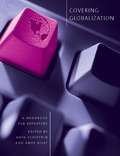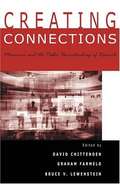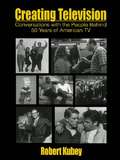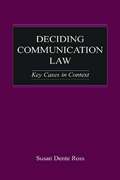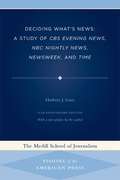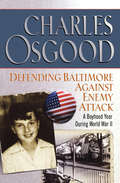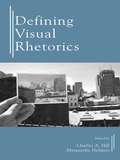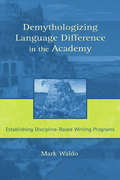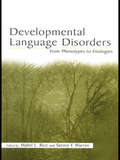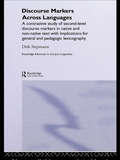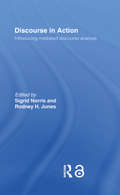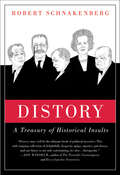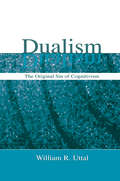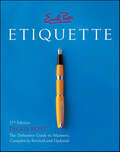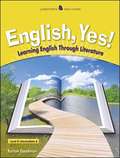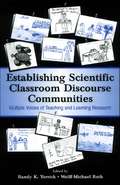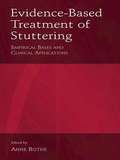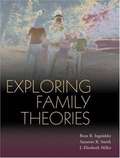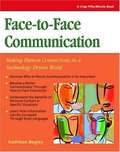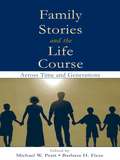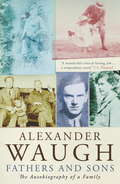- Table View
- List View
Covering Globalization: A Handbook for Reporters
by Amer Bisat Schiffrin Anya Eds.The first journalism textbook for reporters who cover finance and economics in developing and transitional countries, Covering Globalization is an essential guide to the pressing topics of our times. Written by economists from the Asian Development Bank and the International Monetary Fund as well as journalists who have worked for Dow Jones, the Financial Times, the New York Times, Fortune, and Reuters—and with an introduction by Nobel Laureate Joseph E. Stiglitz—this invaluable resource helps reporters write about subjects such as banking and banking crises, pension reform, privatization, trade agreements, central banks, the World Bank, sovereign debt restructuring, commodity markets, corporate governance, poverty-eradication programs, and the "resource curse." Each chapter explains the basic economic principles and current thinking on a given topic and provides tips on what to look for when covering specific subjects; a way to structure business and economics stories; a way to use the Internet for reporting with links to more information online; extensive glossaries and much more.
Creating Connections: Museums and the Public Understanding of Current Research
by Bruce Lewenstein David Chittenden Graham FarmeloThis fundamentally human need to find out about the world led to the creation of this book.
Creating Television: Conversations With the People Behind 50 Years of American TV (Routledge Communication Series)
by Robert KubeyCreating Television brings television and its creators to life, presenting fascinating in-depth interviews with the creators of American TV. Having interviewed more than 100 television professionals over the course of his 15 years of research, Professor Robert Kubey presents here the 40 conversations that provide the most illuminating insights about the industry and the people working in it. These interviews bring television's creators to life, revealing their backgrounds, work, and thoughts about the audience and the television programs they create. Each interview tells a compelling tale of an individual's struggles and successes within a complex collaborative and highly commercial medium, offering readers rare insights on the human component in television's development. Featured in this volume are actors, agents, writers, directors, producers, and executives, representing television's earliest days through to the present day. Spanning shows from I Love Lucy and The Tonight Show through to Seinfeld, The Simpsons, and The Sopranos, these creators share the stories of how they gained entry to the industry and built their careers, offering readers a rare opportunity to meet, up close, the people involved in creating many of the most famous and successful programs in the medium's history, and linking the creators' personal histories to the television programs they create. With its unique insights on the people responsible for making television, this volume will be of interest to scholars and researchers in television history, sociology of culture, human creativity, television production, media studies, and mass media ethics. It will also be a popular reader for undergraduate and graduate students in courses addressing television, mass culture, media and society, American Studies, creativity, television history, and media ethics.
Deciding Communication Law: Key Cases in Context (Routledge Communication Series)
by Susan Dente RossThis clearly written and well-focused volume combines concise decisions of the primary areas of communication law with the foundational case decisions in those domains. Thus, in one volume, students of communication law, constitutional law, political science, and related fields find both the key rulings that define each area of law and a detailed summary of the legal concepts, doctrines, and policies so vital to understanding the rulings within their legal context. The text forgoes the tendency to provide encyclopedic treatment of all the relevant cases and focuses instead on the two or three cases most vital to an accurate and informed understanding of the current state of each field of communication law. The chapters provide readers with the most salient concepts and the necessary depth to understand the law while permitting most reading time to be directed to the law itself. Full-text rulings allow readers to immerse themselves in the law itself--to develop a feel for its complexity, its flexibility, and its language. Useful as a quick reference to the landmark rulings and the jurisprudence of communication law, this book also serves well as the primary text in related undergraduate courses or as a supplemental text in graduate classes in the field.
Deciding What's News: A Study of CBS Evening News, NBC Nightly News, Newsweek, and Time (Medill Visions of the American Press)
by Herbert Gans<p>For ten years, Herbert J. Gans spent considerable time in four major television and magazine newsrooms, observing and talking to the journalists who choose the national news stories that inform America about itself. Writing during the golden age of journalism, Gans included such headline events as the War on Poverty, the Vietnam War and the protests against it, urban ghetto disorders, the assassinations of Martin Luther King, Jr. and Robert F. Kennedy, and Watergate. He was interested in the values, professional standards, and the external pressures that shaped journalists' judgments. <p>Deciding What's News has become a classic. A new preface outlines the major changes that have taken place in the news media since Gans first wrote the book, but it also suggests that the basics of news judgment and the structures of news organizations have changed little. Gans's book is still the most comprehensive sociological account of some of the country's most prominent national news media. The book received the 1979 Theatre Library Association Award and the 1980 Book Award of the National Association of Educational Broadcasters. This is the first work to be published under the Medill School of Journalism's "Visions of the American Press" imprint, a new journalism history series featuring both original volumes and reprints of important classics.</p>
Defending Baltimore Against Enemy Attack: A Boyhood Year During World War II
by Charles OsgoodFrom beloved broadcaster Charles Osgood, a poignant memoir about one unforgettable childhood year during World War II. Defending Baltimore Against Enemy Attack is a gloriously funny and nostalgic slice of American life and a moving look at World War II from the perspective of a child far away from the fighting, but very conscious of the reverberations. With a sharp eye for details, Osgood captures the texture of life in a bygone era.
Defining Visual Rhetorics
by Charles A. Hill Marguerite HelmersImages play an important role in developing consciousness and the relationship of the self to its surroundings. In this distinctive collection, editors Charles A. Hill and Marguerite Helmers examine the connection between visual images and persuasion, or how images act rhetorically upon viewers. Chapters included here highlight the differences and commonalities among a variety of projects identified as "visual rhetoric," leading to a more precise definition of the term and its role in rhetorical studies. Contributions to this volume consider a wide variety of sites of image production--from architecture to paintings, from film to needlepoint--in order to understand how images and texts work upon readers as symbolic forms of representation. Each chapter discusses, analyzes, and explains the visual aspect of a particular subject, and illustrates the ways in which messages and meaning are communicated visually. The contributions include work from rhetoric scholars in the English and communication disciplines, and represent a variety of methodologies--theoretical, textual analysis, psychological research, and cultural studies, among others. The editors seek to demonstrate that every new turn in the study of rhetorical practices reveals more possibilities for discussion, and that the recent "turn to the visual" has revealed an inexhaustible supply of new questions, problems, and objects for investigation. As a whole, the chapters presented here demonstrate the wide range of scholarship that is possible when a field begins to take seriously the analysis of images as important cultural and rhetorical forces. Defining Visual Rhetorics is appropriate for graduate or advanced undergraduate courses in rhetoric, English, mass communication, cultural studies, technical communication, and visual studies. It will also serve as an insightful resource for researchers, scholars, and educators interested in rhetoric, cultural studies, and communication studies.
Defining Visual Rhetorics
by Charles A. Hill Marguerite HelmersImages play an important role in developing consciousness and the relationship of the self to its surroundings. In this distinctive collection, editors Charles A. Hill and Marguerite Helmers examine the connection between visual images and persuasion, or how images act rhetorically upon viewers. Chapters included here highlight the differences and commonalities among a variety of projects identified as "visual rhetoric," leading to a more precise definition of the term and its role in rhetorical studies. Contributions to this volume consider a wide variety of sites of image production--from architecture to paintings, from film to needlepoint--in order to understand how images and texts work upon readers as symbolic forms of representation. Each chapter discusses, analyzes, and explains the visual aspect of a particular subject, and illustrates the ways in which messages and meaning are communicated visually. The contributions include work from rhetoric scholars in the English and communication disciplines, and represent a variety of methodologies--theoretical, textual analysis, psychological research, and cultural studies, among others. The editors seek to demonstrate that every new turn in the study of rhetorical practices reveals more possibilities for discussion, and that the recent "turn to the visual" has revealed an inexhaustible supply of new questions, problems, and objects for investigation. As a whole, the chapters presented here demonstrate the wide range of scholarship that is possible when a field begins to take seriously the analysis of images as important cultural and rhetorical forces. Defining Visual Rhetorics is appropriate for graduate or advanced undergraduate courses in rhetoric, English, mass communication, cultural studies, technical communication, and visual studies. It will also serve as an insightful resource for researchers, scholars, and educators interested in rhetoric, cultural studies, and communication studies.
Demythologizing Language Difference in the Academy: Establishing Discipline-Based Writing Programs
by Mark WaldoIn this volume, Mark Waldo argues that writing across the curriculum (WAC) programs should be housed in writing centers and explains an innovative approach to enhancing their effectiveness: focus WAC on the writing agendas of the disciplines. He asserts that WAC operation should reflect an academy characterized by multiple language communities--each with contextualized values, purposes, and forms for writing, and no single community's values superior to another's. Starting off with an examination of the core issue, that WAC should be promoting learning to write in the disciplines instead of writing to learn, Waldo proposes: *housing WAC in comprehensive writing centers independent of any other department; *using dialogue and inquiry rather than prescriptive techniques in the WAC program's interaction with faculty in other disciplines; and *phasing out writing assessment that depends on one test measuring the writing abilities of students from all disciplines. In the process of making his case, Waldo discusses tutor training, faculty consultancy, and multilayered assessment programs. In addition to presenting the theoretical and practical advantages of discipline-based WAC programs, he also offers clear and compelling evidence from his own institution that supports the success of this approach to writing instruction. Demythologizing Language Difference in the Academy: Establishing Discipline-Based Writing Programs will be of interest to writing program and WAC administrators; writing center administrators; graduate students studying composition; and educators and graduate students involved in WAC initiatives, research, and study.
Developmental Language Disorders: From Phenotypes to Etiologies
by Mabel L. Rice Steven F. WarrenDevelopmental Language Disorders: From Phenotypes to Etiologies is based on the recent conference of the same name sponsored by the Merrill Advanced Studies Center of the University of Kansas. In the past 10 years, considerable advances have taken place in our understanding of genetic and environmental influences on language disorders in children. Significant research in behavioral phenotypes, associated neurocortical processes, and the genetics of language disorders has laid the foundation for further breakthroughs in understanding the reasons for overlapping etiologies, as well as the unique aspects of some phenotypes. Too often the findings are disseminated in a fragmented way because of the discrete diagnostic categories of affectedness. This volume attempts to assimilate and integrate the findings of the transdisciplinary research toward a more coherent picture of behavioral descriptions, brain imaging studies, genetics, and intervention technologies in language impairment. The contributing authors are all scholars with active programs of research funded by the National Institutes of Health involving diverse clinical groups of children with language impairments.
Discourse Markers Across Languages: A Contrastive Study of Second-Level Discourse Markers in Native and Non-Native Text with Implications for General and Pedagogic Lexicography (Routledge Advances in Corpus Linguistics)
by Siepmann DirkThis book offers a corpus-based comparative study of an almost entirely unexplored set of multi-word lexical items serving pragmatic or text-structuring functions. Part One provides a descriptive account of multi-word discourse markers in written English, French and German, focussing on dicussion of interlingual equivalence. Part Two examines the use of multi-word markers by non-native speakers of English and discusses lexicographical and pedagogical implications.
Discourse in Action: Introducing Mediated Discourse Analysis
by Rodney H Jones Sigrid NorrisFrom emails relating to adoption over the Internet to discussions in the airline cockpit, the spoken or written texts we produce can have significant social consequences. The area of Mediated Discourse Analysis considers texts in their social and cultural contexts to explore the actions individuals take with texts - and the consequences of those actions. Discourse in Action: brings together leading scholars from around the world in the area of Mediated Discourse Analysis reveals ways in which its theory and methodology can be used in research into contemporary social situations explores real situations and draws on real data in each chapter shows how analysis of texts in their social contexts broadens our understanding of the real world.Taken together, the chapters provide a comprehensive overview to the field and present a range of current studies that address some of the most important questions facing students and researchers in linguistics, education, communication studies and other fields.
Distory: A Treasury of Historical Insults
by Robert SchnakenbergDistory: A Treasury of Historical Insults is a hilarious collection of insulting historical quotations in the vein of The Portable Curmudgeon that will have history buffs and readers of humor books in stitches. Full of lively quips, jabs, jaunts and put downs by and about notable figures, it covers all epochs of mostly Western history. Schnakenberg has collected more than 600 historical insults into this first collection of its kind.Included:"A German singer! I should as soon expect to get pleasure from the neighing of my horse."- Alexander the Great"Belgium is just a country invented by the British to annoy the French." - Charles de Gaulle"What can you do with a man who looks like a female llama surprised when bathing?"- Winston Churchill on Charles de Gaulle"Jerry Ford is so dumb he can't fart and chew gum at the same time." - Lyndon B. Johnson"Avoid all needle drugs - -the only dope worth shooting is Richard Nixon." - Abbie Hoffman
Dualism: The Original Sin of Cognitivism
by William R. UttalDirected to scholars and senior-level graduate students, this book is an iconoclastic survey of the history of dualism and its impact on contemporary cognitive psychology. It argues that much of modern cognitive or mentalist psychology is built upon a cryptodualism--the idea that the mind and brain can be thought of as independent entities. This dualism pervades so much of society that it covertly influences many aspects of modern science, particularly psychology. To support the argument, the history of dualism is extended over 100,000 years--from the Paleolithic times until modern philosophical and psychological thinking. The questions regarding this topic that are answered in the book are: 1) Does dualism influence the scientific theories of psychology? 2) If so, should dualism be put aside in the search for a more objective analysis of human mentation?
Edward R. Murrow and the Birth of Journalism
by Bob EdwardsThis is a biography of Edward R. Murrow written by one of NPR's most respected journalists, Bob Edwards, best known for hosting Morning Edition.
Emily Post's Etiquette: The Definitive Guide to Manners
by Peggy Post“[A] compendium of socially acceptable responses to every conceivable opportunity for personal embarrassment or inadvertent insult.” —Publishers WeeklyRead by millions since the first edition was published in 1922, Emily Post—the most trusted name in etiquette—has always been there to help people navigate every conceivable social situation. The tradition continues with this 100 percent revised and updated edition, in which Peggy Post covers the formal, the traditional, the contemporary, and the casual. Based on thousands of reader questions and surveys, the book shows how to handle the new, difficult, unusual, and everyday situations we encounter. The definition of etiquette—a code of behavior based on thoughtfulness—has not changed since Emily’s day. The etiquette guidelines we use to smooth the way change all the time. This new edition resolves hundreds of our key etiquette concerns: dealing with rudeness, netiquette, noxious neighbors, road rage, family harmony, online dating, cell phone courtesy, raising respectful children and teens, and travel etiquette in the post-9/11 world . . . to name just a few.Emily Post's Etiquette, 17th Edition also remains the definitive source for timeless advice on entertaining, social protocol, table manners, guidelines for religious ceremonies, expressing condolences, introductions, how to be a good houseguest and host, invitations, correspondence, planning a wedding, giving a toast, and sportsmanship. Peggy Post's advice gives us the confidence of knowing we're doing the right thing so we can relax and enjoy the moment—and move more easily through our world.
English, Yes!: Intermediate A
by Glencoe Mcgraw-HillEnglish, Yes! uses multicultural literature as the foundation for improving comprehension, vocabulary, grammar, and writing. Adapted selections from classic and contemporary authors of many cultures engage students in learning English.
Establishing Scientific Classroom Discourse Communities: Multiple Voices of Teaching and Learning Research
by Wolff-Michael Roth Randy YerrickEstablishing Scientific Classroom Discourse Communities: Multiple Voices of Teaching and Learning Research is designed to encourage discussion of issues surrounding the reform of classroom science discourse among teachers, teacher educators, and researchers. The contributors--some of the top educational researchers, linguists, and science educators in the world--represent a variety of perspectives pertaining to teaching, assessment, research, learning, and reform. As a whole the book explores the variety, complexity, and interconnectivity of issues associated with changing classroom learning communities and transforming science classroom discourse to be more representative of the discourse of scientific communities. The intent is to expand debate among educators regarding what constitutes exemplary scientific speaking, thinking, and acting. This book is unparalleled in discussing current reform issues from sociolinguistic and sociocultural perspectives. The need for a revised perspective on enduring science teaching and learning issues is established and a theoretical framework and methodology for interpreting the critique of classroom and science discourses is presented. To model and scaffold this ongoing debate, each chapter is followed by a "metalogue" in which the chapter authors and volume editors critique the issues traversed in the chapter by opening up the neatly argued issues. These "metalogues" challenge, extend, and deepen the arguments made. Central questions addressed include: *Why is a sociolinguistic interpretation essential in examining science education reform? *What are key similarities and differences between classroom and scientific communities? *How can the utility of common knowledge and existing classroom discourse be balanced toward alternative outcomes? *What curricular issues are associated with transforming classroom talk? *What other perspectives can assist in creating multiple access to science through redefining classroom discourse? Whether this volume improves readers' science teaching, assists their research, or helps them to better prepare tomorrow's science teachers, the goal is to engage them in considering the challenges faced by educators as they navigate the seas of reform and strive to improve science education for all.
Everyday Letters for Busy People: Hundreds Of Samples You Can Adapt At A Moment's Notice
by Debra Hart May Regina McAloneyNow revised and updated: Hundreds of tips, techniques, and samples to help you write the perfect letter (or e-mail) no matter what the occasion.A text message may be fast—but sometimes only a letter will do. Writing a good letter takes time and thought, but there are ways to make the process faster, easier, and more effective.With Everyday Letters for Busy People as your guide, you can write the kind of letters that get action, build relationships, ease tense situations, and get your message across. Everyday Letters for Busy People includes a wide variety of sample letters you can use or adapt at a minute’s notice including:Business letters • Complaint letters • Community action letters • Job-search letters • Letters to government officials and agencies • Thank-you letters • Invitations • Condolences • Resignations and many moreWith a new section on how to write concise, polite, and effective e-mails, Everyday Letters for Busy People will not only help you compose the sharpest interview follow-up, the kindest thank you, the most heartfelt condolence, and the most effective complaint letter, it will also direct you in proper letter etiquette and help you become a better writer.
Evidence-Based Treatment of Stuttering: Empirical Bases and Clinical Applications
by Anne K. BotheThis book is the result of a "State-of-the-Art-Conference" held at the University of Georgia dedicated to the evidence-based treatment of stuttering. An international group of prominent fluency researchers and clinicians were invited to present and discuss current data and issues related to the treatment of stuttering. The topic was defined to include evidence about stuttering, evidence about stuttering treatment, and discussions of how that evidence should guide the continuing research and practice. The explicit link between empirical evidence and suggestions for clinical practice is the goal of the book. The book begins by addressing the notion of "evidence-based practice" and considers its implications for stuttering treatment. Part II presents the intersection of the nature of stuttering; the theories of stuttering; and the implications of nature, theory, and other knowledge for stuttering treatment decisions. Part III provides two of the many measurement issues facing stuttering treatment followed by Part IV, which is devoted to the quality of treatment research evidence, for specific treatments and in terms of some more general methodological and professional issues. The final part summarizes the clinical recommendations made throughout the book and discusses evidence-based, outcomes-focused clinical decisions for stuttering. These chapters are intended to provide "state-of-the-art" information to researchers, clinicians, and students who are interested in developing, identifying, or using the best possible evidence-based treatments for stuttering.
Exploring Family Theories
by Bron B. IngoldsbyThe purpose of this text is to provide a basic introduction to the major theories pertaining to the family among professionals today. Each addresses different aspects of family life and answers different questions. Humans are extremely complex, and it is difficult to analyze ourselves; therefore, every theory will be imperfect. But each one brings us closer to understanding and being able to make positive change where needed in family life. Each theory has its own basic assumptions and concepts, and is a product of its own historical context as well. Each is used in answering specific research questions that other theories may not answer, or may answer differently. It will be up to you to try on the lens of each theory and determine how well you think it explains human and family behavior.
Face-to-Face Communication: Making Human Connections in a Technology-Driven World
by Kathleen A. BegleyEven as technology has allowed us to connect with an ever-expanding global network through the click of a mouse, face-to-face communication is still as important as ever. Improving one's in-person communication may seem nonessential and downright quaint in this computerized age, yet many workplace situations, often those involving conflict, feelings, or other sensitive issues, still demand human contact. FACE-TO-FACE COMMUNICATION explores why personal contact remains the most powerful type of human interaction and what readers can do to improve their skills to become excellent communicators.
Family Stories and the Life Course: Across Time and Generations
by Michael W. Pratt Barbara H. FieseThis edited book draws from work that focuses on the act of telling family stories, as well as their content and structure. The process of telling family stories is linked to central aspects of development, including language acquisition, affect regulation, and family interaction patterns. This book extends across traditional developmental psychology, personality theory, and family studies. Drawing broadly on the epigenetic framework for individual development articulated by Erik Erikson, as well as on conceptions of the family life cycle, the editors bring together contemporary examples of psychological research on family stories and their implications for development and change at different points in the life course. The book is divided into sections that focus on family stories at different points in the life cycle, from early childhood and the beginnings of narrative skill, through adolescence, young adulthood, midlife, and then mature adulthood and its intergenerational meaning. During each of these periods of the life cycle, research focusing on individual development within an Eriksonian framework of ego strengths and virtues is highlighted. The dynamic role of family stories is also featured here, with work exploring the links between family process, intergenerational attachment, and storytelling. Sociocultural theories that emphasize how such development is situated in the wider cultural context are also featured in several chapters. This broad lifespan developmental focus serves to integrate the exciting diversity of this work and foster further questions and research in the emerging field of family narrative. The book is intended primarily for researchers and advanced-level students in the fields of developmental and personality psychology, as well as those in family studies and in gerontology. It may also be of interest to those in the helping professions who are concerned with family therapy and family issues, and may--due to its content and illustrative material--have appeal to a wider market of the lay public. The chapters are written in a readily accessible style and the analyses are presented in a fairly non-technical way. Because family stories are charted across the lifespan, it would be a suitable companion book to a more traditional lifespan textbook in certain courses.
Fathers and Sons
by Alexander WaughThe Waugh family has been writing books since the nineteenth century. Evelyn's father, brother and son were all writers and now his grandson has taken up the baton. Based on recollections of his father, Auberon, and on a mine of hitherto unseen documents relating to Evelyn and his close family, Alexander Waugh skilfully traces the threads of influence that have linked father to son across a century of conflict, turmoil and change.FATHERS AND SONS is much more than a family tale: it is a study of birth and death, of writers and writing, of conforming and rebelling. It is a frank and intimate memoir, a revealing history and a book about famous men.
Fathers and Sons
by Alexander WaughThe Waugh family has been writing books since the nineteenth century. Evelyn's father, brother and son were all writers and now his grandson has taken up the baton. Based on recollections of his father, Auberon, and on a mine of hitherto unseen documents relating to Evelyn and his close family, Alexander Waugh skilfully traces the threads of influence that have linked father to son across a century of conflict, turmoil and change.FATHERS AND SONS is much more than a family tale: it is a study of birth and death, of writers and writing, of conforming and rebelling. It is a frank and intimate memoir, a revealing history and a book about famous men.
